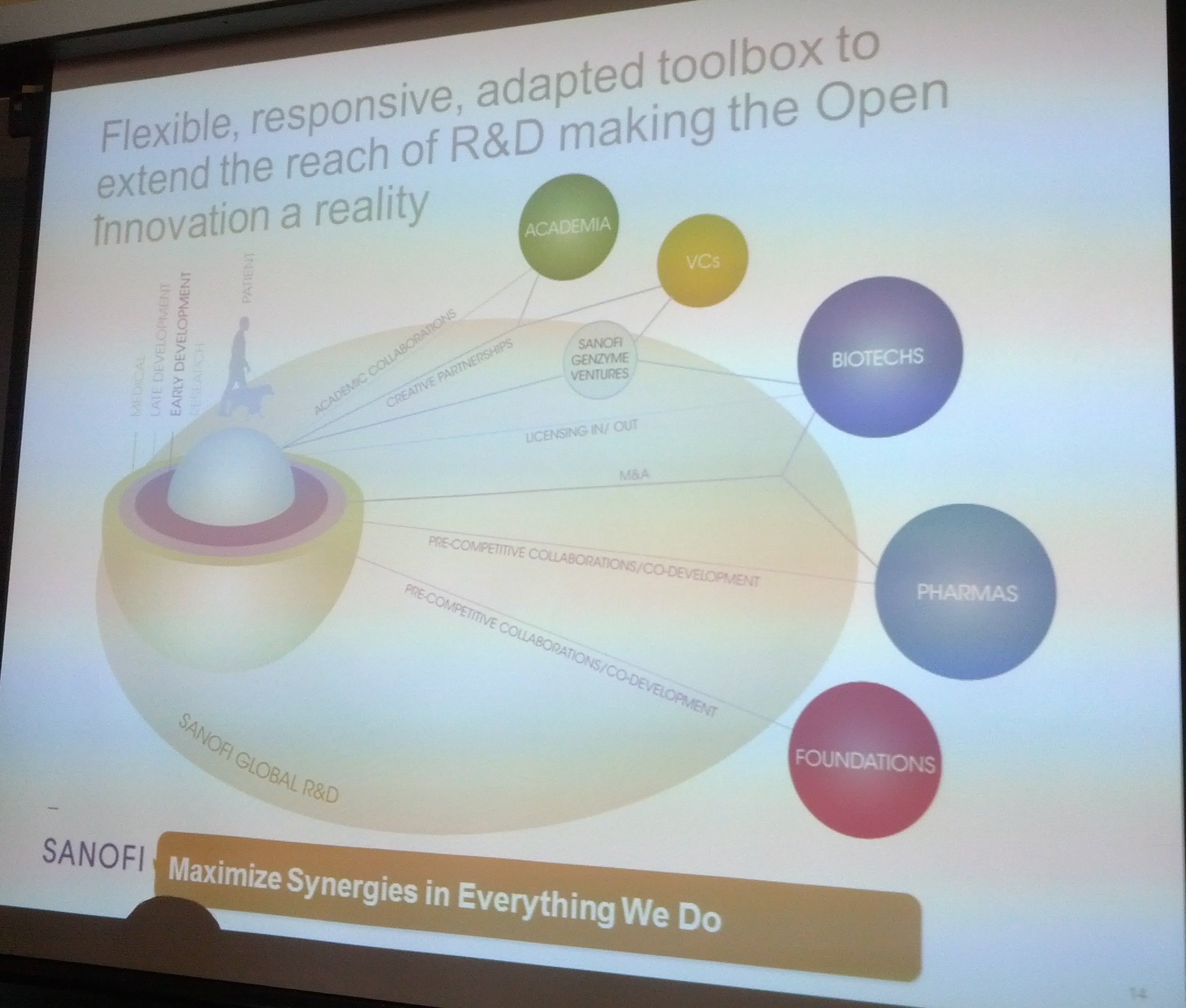*This post was written for the Biotech in Wisconsin blog and is cross posted here.*
This week we had a group from Sanofi R&D come to Wisconsin for a range of activities that culminated with Dr. Elias Zerhouni, the President of Global R&D, talking about the approach to developing new drugs at a breakfast gathering of biotech industry folks. If you aren’t familiar with Dr. Zerhouni’s background, he’s had the opportunity to work across the healthcare industry spectrum – from a background in radiology at Johns Hopkins to founding start-up companies to director of the National Institutes of Health (NIH) to his current position at Sanofi.
Open Innovation @ Sanofi
Dr. Zerhouni talked about the Sanofi R&D philosophy that is built on translational research and open innovation. During the discussion about open innovation, Dr. Zerhouni showed a slide that is easiest to describe as a network diagram showing how Sanofi and Sanofi Genzyme Ventures connect to the other players in the ecosystem, Academia, Biotechs, VCs, Pharma, Foundations. The slide was up for quite a bit and I got to thinking that the diagram could be overlaid with some of the things we’ve been talking about here in Wisconsin. Can we balance or offset some of the weaker parts of our ecosystem with the strengths we do have? As an example, could we offset the relative dearth of venture capital invested in Wisconsin ($95.7M across industries in 2012) with strength in clinical trials (home to nearly 9% of US clinical trials in 2010)?
Open Innovation & Network Effects
After his talk and a bit of Q&A, I had the chance to talk with Dr. Zerhouni one on one – with an interesting twist that my introduction was as a cancer drug developer and blogger. After chatting about RNA as an oncology target, I asked Dr. Zerhouni about his thoughts on how smaller biotech hubs like Wisconsin could build on this model of Open Innovation.
As we talked, Dr. Zerhouni gave examples of how the following three factors have impacted Sanofi and then we discussed how they could impact Wisconsin.
Connectors are important because they are the people in a community who know a wide variety of people. (You may recognize this idea from a number of places, including Gladwell’s The Tipping Point.) From an internal (in Wisconsin) perspective, Dr. Zerhouni said in an environment with fewer resources connectors are even more important to ensure efficiencies. The cost of overlapping assets vs. shared assets is high so knowing what is available is important. His comments struck me in part because of the focus we generally have on external (outside Wisconsin) connections. Just this week, I wrote about a project we’re kicking off to tell the stories of Wisconsin biotech and my realization that the effort is as important internally as externally.
Next up Dr. Zerhouni talked about Metcalfe’s law – that the value of a network is proportional to the square (not the sum) of the connections. As I was playing catch up afterward reading about Metcalfe’s Law (and Reed’s and Odlyzko’s laws), I came across some research on network exclusion – what happens when people are left out of the network. Something I’ve seen is that while there are a variety of opportunities around town to make connections, the crowd ends up being mostly the same. My brief read on network exclusion suggests that finding a way to capture more people in our network would not only benefit them but also our ecosystem.
Finally Dr. Zerhouni talked about the opportunity that social media provides. I was glad to hear him talk about the interesting things Sanofi learned about while they were here but his examples confirmed that we have a lot of work to do to make our work here more visible. Dr. Zerhouni said blogs and other social media were a great way to make that happen (and of course I agreed). Combining network inclusion and social media, there are social media tools that reduce the barriers to connecting. A local example is the Madison Health Tech meetup, Meetup provides an easy to use platform and group members provide the topics of interest, set the times they want, etc. If imitation is the sincerest form of flattery, I recently set up a Biotech in Wisconsin meetup that will launch next month.
Drug Development – A Public Interest
I’m finishing my post where Dr. Zerhouni started – that drug development is a public interest. He reminded the group that there are patients at the end of this process and we need to get connected with what patients need. If successful, open innovation means connecting and networking with people whose work is guided by what patients are telling them they need. I think the underpinning of success will be efficient and meaningful communication across the systems and Dr. Zerhouni has some interesting ideas for Sanofi (and Wisconsin).
Special thanks to the folks at BioForward for setting up the Sanofi R&D visit!



Be the first to comment